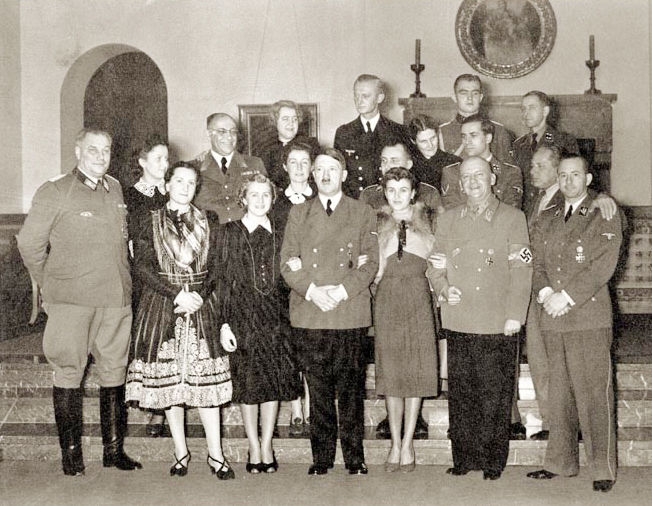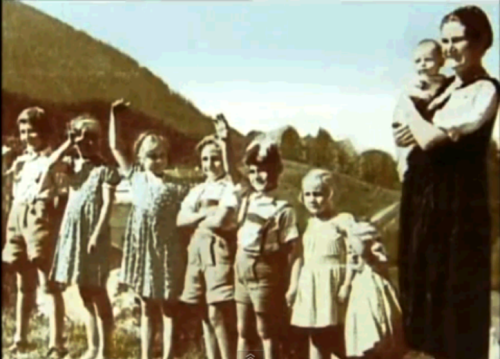Welcome to DU!
The truly grassroots left-of-center political community where regular people, not algorithms, drive the discussions and set the standards.
Join the community:
Create a free account
Support DU (and get rid of ads!):
Become a Star Member
Latest Breaking News
General Discussion
The DU Lounge
All Forums
Issue Forums
Culture Forums
Alliance Forums
Region Forums
Support Forums
Help & Search
Learning About Nazi Psychology From 'Nazi Wives: The Women At The Top of Hitler's Germany'

- Adolf Hitler (1889-1945) with guests at at his residence on Dec. 31, 1939. Gerda Bormann is in the back row, 4th from left. Getty Images.
_________
- 'What We Can Learn About Nazi Psychology From the Wives of Hitler’s Top Officials,' By James Wyllie, TIME, *Nov. 20, 2020. - Excerpts from the book, 'Nazi Wives' (2019) by James Wyllie.
Among the thousands of books about Nazism, barely a handful focus on the wives of the leading figures in Hitler’s regime. While their men have left an indelible imprint on our collective memory the women who gave them vital support, encouragement and direction have largely remained relegated to the footnotes of history. Part of the reason for this is the nature of the source material, much of which has to be treated with caution. Although a lot more information has come to light in the last few decades, there are still considerable gaps and chunks of time missing from the diaries and letters that have survived, while the post-war autobiographies penned by several of the wives actively sought to portray their husbands as paragons of virtue and themselves as innocent bystanders.
However, the Nazis set out to control every aspect of their citizens’ existence—the food they ate, the clothes they wore, who they had sex with, what jokes they could tell, how they celebrated Christmas—making any separation between the public and the private meaningless. And even though they might not have been privy to their husbands’ daily decisions, the evidence of their murderous work was all around: the looted art on the walls; the furniture made from human skin and bones stashed in the attic; the fruit and vegetables taken from the local concentration camp gardens; the slave labor tilling their land. The rituals of family life—births, weddings, funerals—were inextricably linked to Nazi ideology. Perhaps this is why it has proved easier to take these women at face value and treat them as minor characters; treating them seriously means accepting that their husbands engaged in normal activities and experienced recognizably human emotions.
Falling in and out of love. Worrying about the bills and their weight and where to send the kids to school. Planning dinner parties and picnics. Spending vacations sightseeing. Acknowledging that in many respects they were no different from the rest of us creates a form of cognitive dissonance: a deeply uneasy feeling.
Yet their story offers important insights into the nature of Nazi rule and the psychology of its leaders, providing a fresh perspective on the key events that shaped its rise and fall.

- Excerpted from 'NAZI WIVES: The Women at the Top of Hitler’s Germany,' by James Wyllie, 2019.
Gerda Bormann, wife of Martin Bormann, Hitler’s private secretary, was in many ways the ideal Nazi wife. She didn’t use cosmetics, had her blonde hair in a plait and wore traditional Bavarian dress, as did her children; in the few images of them that survived they look like they’ve just stepped off the set of The Sound of Music. At home, Gerda submitted without question to her husband’s demands. She had no public profile and no place in the regime’s publicity campaigns; at the party events she was obliged to attend, she remained hidden in the background. Most of all, she was a prodigious mother, producing children at a heroic rate: between 1933 and 1940, Gerda added five more to the two she already had.
As far as the Nazis were concerned, this was a woman’s essential function: to drive population growth. Increasing the birth rate was an overriding goal and the regime mobilized its forces to achieve this aim: there were economic incentives and cash handouts for large families; the propaganda machine made films, broadcast radio shows and staged exhibitions that glorified motherhood; the medical profession and the scientific community—especially nutritionists and fertility experts—got in on the act; and the Gestapo policed those considered unfit to be mothers. Overall, though the birth rate increased under those efforts—in 1933 there were just under 15 live births per 1,000 people, which had risen to 20 by 1939—it was still slightly less than it was in 1925, while the number of families with more than four children had dropped from a quarter in 1933 to a fifth in 1939. Gerda, of course, was the exception to the rule...
More, https://time.com/5910807/nazi-wives/
______________
-> VIDEO: 'Nazi Princesses, The Fates of Top Nazis' Wives & Mistresses,' Bios, Photos,
https://democraticunderground.com/11661921

- Gerda Bormann, wife of Martin Bormann with their children. The couple had 10 children.
InfoView thread info, including edit history
TrashPut this thread in your Trash Can (My DU » Trash Can)
BookmarkAdd this thread to your Bookmarks (My DU » Bookmarks)
4 replies, 1813 views
ShareGet links to this post and/or share on social media
AlertAlert this post for a rule violation
PowersThere are no powers you can use on this post
EditCannot edit other people's posts
ReplyReply to this post
EditCannot edit other people's posts
Rec (14)
ReplyReply to this post
4 replies
 = new reply since forum marked as read
Highlight:
NoneDon't highlight anything
5 newestHighlight 5 most recent replies
= new reply since forum marked as read
Highlight:
NoneDon't highlight anything
5 newestHighlight 5 most recent replies
Learning About Nazi Psychology From 'Nazi Wives: The Women At The Top of Hitler's Germany' (Original Post)
appalachiablue
Feb 2021
OP
msongs
(67,398 posts)1. magda goebbels was a player nt
appalachiablue
(41,131 posts)2. One of the Real Housewives of Nazi Germany, as
a WaPo writer dubbed them. Funny, not funny.
Blue Owl
(50,355 posts)3. Stephen Milier's wife?
appalachiablue
(41,131 posts)4. Good point, sheesh. Coney-Barrett.